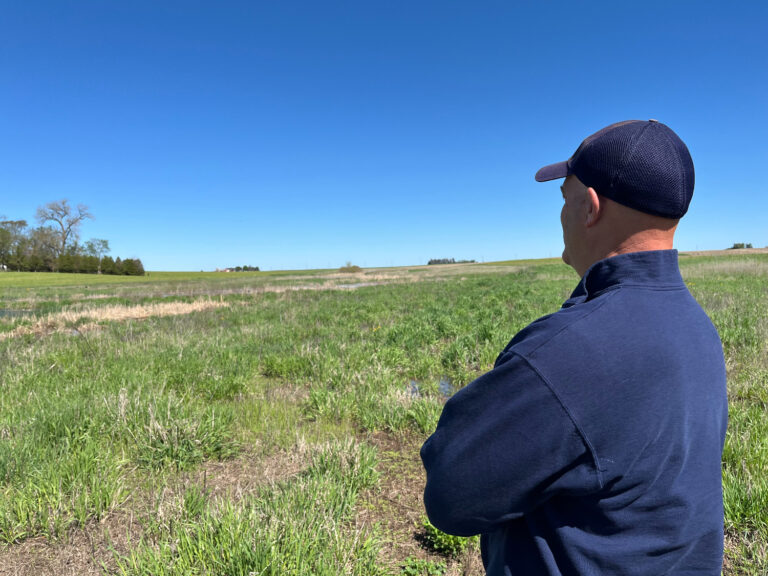Planting is well underway across the Midwest, but farmers are still grappling with dry conditions that led to lower than normal corn yields last fall. It’s the third year of a near historic drought for parts of the Corn Belt.
Mark Mueller’s farm in Bremer County, Iowa, sat within a pocket of extreme drought in the northeast part of the state until a rainy April lifted the area into severe drought.
The fourth generation farmer says last year’s crop was below expectations, and even with recent rains, they’re still behind.
“It’s not quite Corn Belt-wide like it was during the Dust Bowl days,” he says, “but it could also develop into a Dust Bowl-type thing. All it has to do is quit raining tomorrow, and we’ll be dry within a month.”

Mueller typically plants two-thirds corn and one-third soybeans across his fields. This year, because of the drought, he’s scaling back his corn crop and splitting it closer to 50-50 ratio with his soybeans.
Planting is well underway across the Midwest and Great Plains, and farmers in several regions are making similar adjustments, as much of the Corn Belt enters a third year of drought. The U.S. Drought Monitor shows significant areas of Kansas and Iowa are in severe drought, while portions of Nebraska, Oklahoma, Missouri, Minnesota and Wisconsin are also affected.
Dennis Todey, director of the USDA’s Midwest Climate Hub, said the area’s been parched for a historically long time.
“We would probably have to go back to some period in the 1950s or even some in the 1930s to compare with what we’ve seen in the way of longevity and precipitation deficit we’re dealing with,” he said.
The dry conditions have extended from Todey’s home base in Ames, Iowa, to Michigan’s Upper Peninsula to as far south as the Ozarks, with a few wet pockets further east in Illinois and Indiana.
Todey says with less precipitation over the past few years, groundwater for corn could be a problem this season, as well.
“Because of the lack of rainfall over a longer period, deeper soil moisture profiles are dry,” he says. “Groundwater is being limited in some areas.”

In Wisconsin, officials said resilient groundwater reservoirs helped bring in better than expected yield last fall, despite dry conditions. But Sam Bibby, a crop educator with the University of Wisconsin Extension, said they can’t rely on that this year.
“If we ended up in a situation like we did last year during the summer, it would certainly be a lot worse than last year just because we are lower on that subsoil moisture,” he said.
The dry conditions are having impacts on livestock producers, as well.
In southeast Missouri, first-generation rancher August Horstmann says they weren’t able to raise their own hay, because of the dry weather. That led him to a tough decision.
“We were buying $108 hay,” he said. “You can only buy so much of that to get by, so we actually destocked 50% of our cow herd last year.”
To lower his feed costs, Horstmann is currently converting entire grazing fields back to native grasses to help keep subsoil moisture and his livestock’s food sources stable. He said so far it’s been a huge success.
“Our planted cover crops haven’t done very well at all,” Horstmann said. “But the native grasses – the old prairies that were here – performed really well in the drought we’ve had.”
Those changes helped Horstmann feel more confident, despite the dry conditions, and he recently bought 80 head of cattle.
“It looks like this is going to be one of our better grazing seasons, and it’s still very dry,” he said.

But in Iowa, where it’s been even drier, state extension field agronomist Terry Basol says they’ll be even more dependent on rainfall this year as the soil has mostly dried out.
And he said there’s a lot of catching up to do.
“Our 30-year average is roughly 30 inches of rain,” he said, “and last year, that total was 13-point-8.”
Despite 4 inches of rain in April, this year’s totals are still about 3 inches short of that. Basol’s concerned about conditions, but trusts in the ingenuity of regional producers to make it through the dry spell.
“You have to have some hope, sometimes I call it faith, to get everybody through,” he said. “Growers are resilient, they’ll make it through.”
This story was produced in partnership with Harvest Public Media, a collaboration of public media newsrooms in the Midwest. It reports on food systems, agriculture and rural issues.

